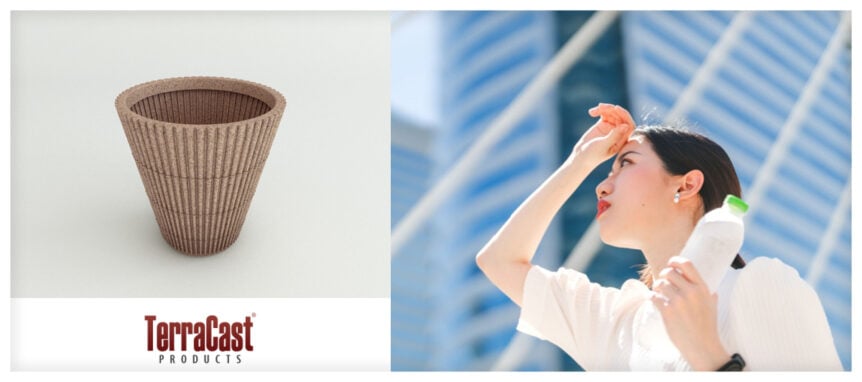Urban centers are heating up faster than surrounding rural areas due to a phenomenon known as the urban heat island effect. Concrete, asphalt, and glass absorb and radiate heat, pushing city temperatures significantly higher, especially in summer. While greenery can help cool things down, maintaining healthy plants in these harsh environments presents a major challenge. That’s where self-watering resin planters offer a smarter, more resilient solution.
Understanding the Urban Heat Island Challenge
In dense cityscapes, natural surfaces are often replaced by impermeable materials that trap solar radiation and block moisture retention. This leads to elevated surface and air temperatures, sometimes by as much as 7°F higher than in nearby rural areas. Plants can mitigate this heat by providing shade and releasing moisture through transpiration, but they need consistent hydration to survive, especially in planters exposed to direct sunlight.
Traditional planter setups struggle to meet the needs of vegetation in urban heat islands. Frequent manual watering is labor-intensive, costly, and often inefficient. Without a reliable irrigation method, plants in these zones are prone to dehydration, root shock, and eventual failure.
The Smart Solution: Self-Watering Resin Planters
To support healthy urban greenery, self-watering systems, especially when paired with resin planters, provide an effective, low-maintenance option for landscape architects and municipalities.
Self-watering inserts sit at the bottom of a planter and act as a built-in reservoir, slowly distributing water to plant roots via capillary action. This method allows the plant to draw up moisture as needed, maintaining hydration without the risk of oversaturation. A PVC fill tube allows for easy, infrequent refills, which helps reduce both water waste and labor costs.
When these inserts are combined with non-porous, lightweight resin planters, the results are even more powerful. Resin planters help retain moisture because they don’t allow water to seep through like clay or concrete. This enhances the efficiency of the self-watering system and ensures long-term plant health, even during heat waves.
Why Resin Is Ideal for High-Heat Urban Settings
Resin offers unique performance advantages over traditional planter materials in hot climates:
- UV Resistance: High-quality resin planters are UV-stabilized, which means they won’t crack, warp, or fade in direct sunlight.
- Temperature Stability: Unlike metal, resin does not become dangerously hot to the touch. This creates safer public environments, especially in parks, plazas, and other shared spaces.
- Lightweight Durability: Resin planters are strong enough to withstand harsh conditions, yet lightweight enough to move or reconfigure as needed.
- Low Maintenance: Graffiti-resistant finishes and non-porous construction make cleaning easy, even in heavily trafficked locations.
These advantages are especially relevant for cities where high temperatures and foot traffic are daily realities. By choosing resin over heavier, heat-retaining materials, city planners reduce the risk of plant stress, infrastructure damage, and frequent replacement.
Better Performance in Heat Islands
Healthy greenery contributes significantly to cooling down heat islands. Trees, shrubs, and flowering plants offer shade, absorb carbon dioxide, and release moisture into the air—all of which help lower ambient temperatures. But to be effective, they must be healthy and resilient, and that starts with the right planting system.
When used in medians, curb bump-outs, rooftop gardens, and transit corridors, resin planters with self-watering inserts allow urban greenery to flourish with less oversight. Cities can avoid overwatering in cooler months and avoid underwatering during dry spells. This adaptability supports a wider plant palette and leads to more visually appealing and environmentally beneficial installations.
Long-Term Urban Sustainability
Supporting greenery in heat-stressed areas is not just about aesthetics—it’s about long-term sustainability. Municipal budgets are already stretched thin, and daily hand-watering or irrigation system repairs aren’t always practical. Resin planters with modular, removable self-watering inserts allow cities to upgrade their existing greenery without replacing the entire container, maximizing the value of prior investments.
Multiple insert sizes also ensure flexibility, accommodating different shapes and planter styles across a variety of site conditions. The ability to remove inserts during colder months or extreme weather also adds to their utility and lifespan.
A Smarter Path Forward
As cities continue to combat the effects of climate change and rising temperatures, they must rethink how they support public landscaping. Heat islands will remain a pressing concern—but resin planters equipped with self-watering systems provide a reliable tool in the fight for greener, cooler cities.
This solution isn’t just practical, it’s scalable. Whether you’re revitalizing a downtown corridor, launching a community garden project, or maintaining median landscaping along a busy road, resin planters with self-watering inserts help plants survive and thrive where traditional methods often fail.
To explore planter options designed to perform in the toughest urban environments, contact the TerraCast® team here.

